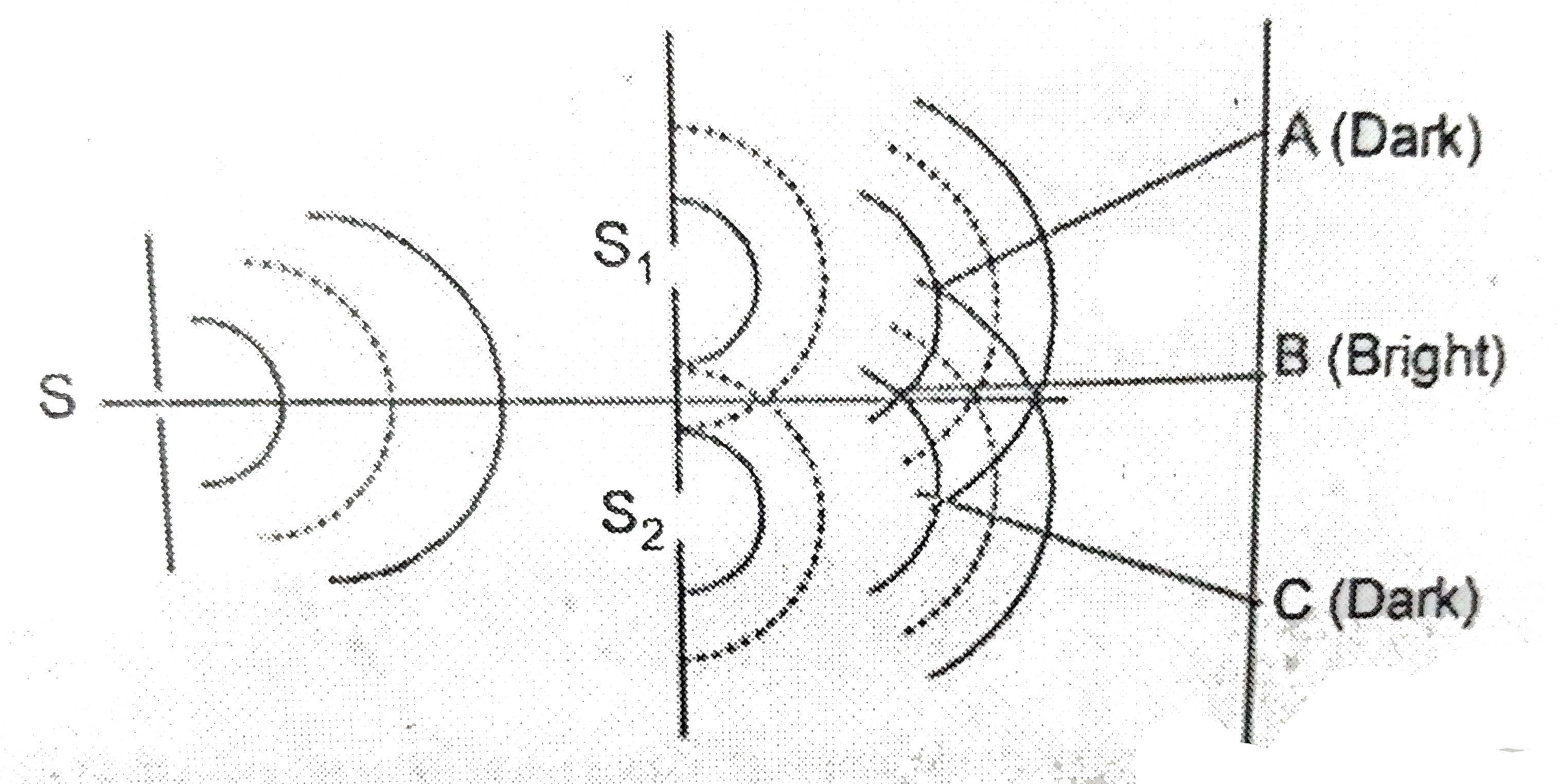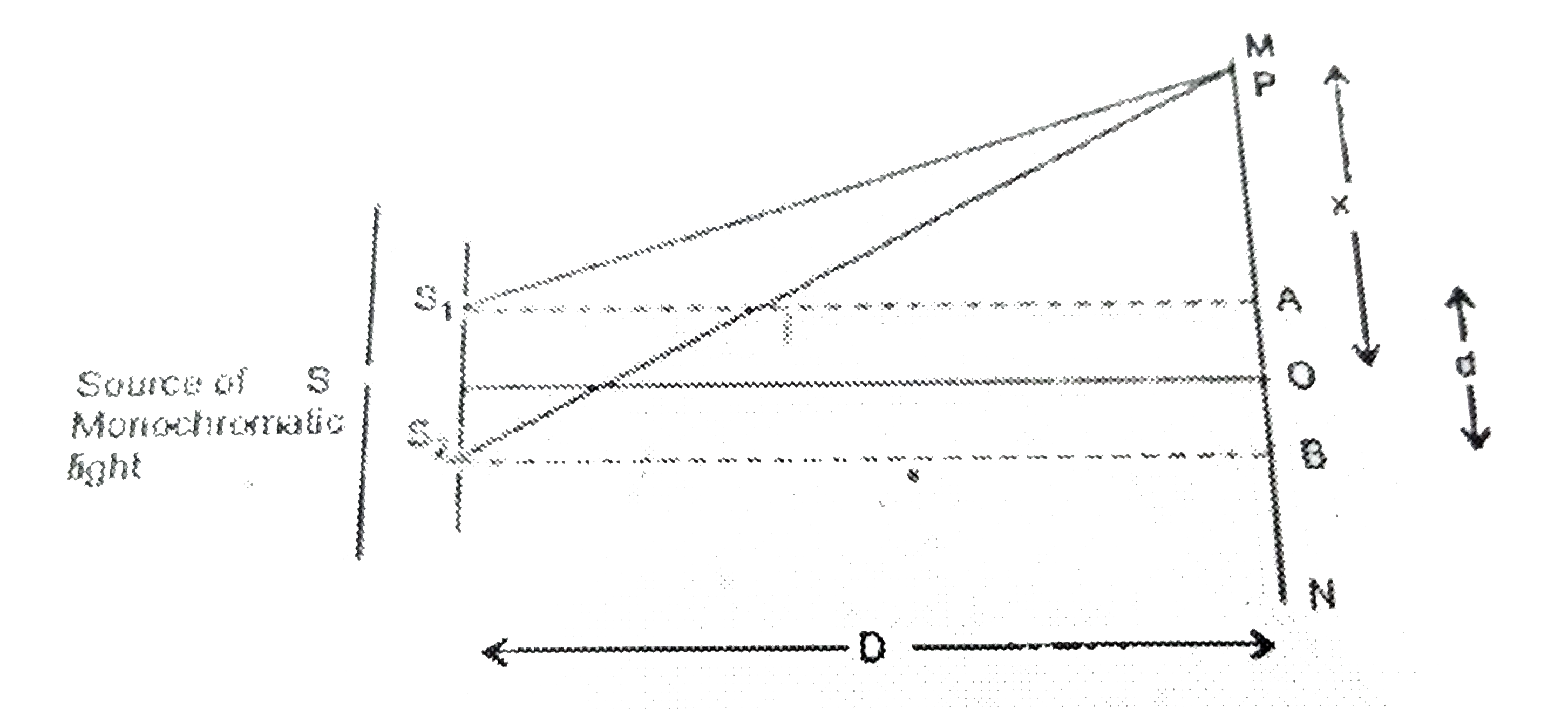Describe Young's double slit experiment to produce interference pattern due to a monochromatic source of light. Deduce the expression for the fringe width.
Simplest experiment to show interference of light is Young's double slit experiment : δ is a narrow slit (of width about 1 mn) illuminated by a monochromatic source of light. At a suitable distance (≈10mm) form δ, two slits S1andS2 are placed parallel to S. When a screen is placed at a large distance (about 2m) from the slit S1andS2, alternate dark and bright bands appear on the screen. These are the interference bands or fringas. The bond disappear when either slit is covered.
Explanation : According to Huygen's pricipal, the monochromatic source of light illuminating the slit S tends out spherical wavefront.
The two waves of same amplitude and same freqency superimpose on each other.
Dark fringes appear on the screen when the crest of one wave falls on the trough of other and they neutralise the effect of each other.
Bright fringes appear on the screen when the crest of one wave coincides with the crest of other and they reinforce each other.
Expression for the fringe width :
Let d= distance between slits S1andS2
D= distance of screen from two slits
and x = distance between the central maxima O and observation point P.


Light waves spread out from S and fall on both S1andS2. The spherical waves emanating from S1andS2 will produce interference frings on the screen MN.
In right ΔS1AP, we have,
(S1P)2=(S1A)2+(AP)2
S1P=√D2+(x−d2)2=
⎷D2⎡⎢
⎢
⎢⎣1+(x−d2)2D2⎤⎥
⎥
⎥⎦
S1P=D⎡⎢
⎢
⎢⎣1+(x−d2)2D2⎤⎥
⎥
⎥⎦=D+(x−d2)22D
Similarly S2P=D+(x+d2)22D
Hence, path difference =S2P−S1P
=D+(x+d2)22D−D−(x−d2)22D=12D[x2+d24+xd−x2−d24+xd]
=12D.2xd=xdD.
Now the intesity at point P is maximum or minimum according as the path difference is an integral multiple of wavelength or an odd intefral multiple of half wavelength.
(i) For Brigth fringe (constructive interference) : We will have constructive interference resulting in a bright fringe when path difference =nλ
xdD=nλ⇒x=nλDd
∴n=nλDd
where, n=0±1±2...
Since, the separation between the centres of two consecutive bright fringes is called fringe width. It is denoted by β
∴ Fringe width, β=xn+1−xn.
β=(m+1)λDdnλDd=λDd(n+1−n)
∴β=λDd
(ii) For Dark fringe (destructive interference): We will have destructive interference resulting in a dark fringe when path difference
=(2n+1)λ2
xdD=(2n+1)λ2⇒x=(2n+1)λD2d
∴xn=(2n+1)λD2d,
where, n=0,±1,±2,...
Fringe width β=xn+1−xn
=[2(n+1)+1]λD2d−(2n+1)λD2d=(2n+2+1−2n−1)λD2d=2λD2d
∴β=λDd
Hence, all bright and dark fringes are of equal width.
Observations :
(i) Fringe width is directly proportional to the wavalength of light i.e. βαλ.
(ii) Fringe width is inversely proportional to the distance between screen and two sourves i.e. βα1d.
(iii) Fringe width is directly proportional to the distance between screen and two sources i.e. βαD
Topper's Solved these Questions
- XII BOARDSBOOK - XII BOARD PREVIOUS YEAR PAPER ENGLISHCHAPTER - XII BOARDSEXERCISE - SET-II, DELHI BOARD
4 Videos
- XII BOARDSBOOK - XII BOARD PREVIOUS YEAR PAPER ENGLISHCHAPTER - XII BOARDSEXERCISE - SET-III, DELHI BOARD
4 Videos
- XII BOARDSBOOK - XII BOARD PREVIOUS YEAR PAPER ENGLISHCHAPTER - XII BOARDSEXERCISE - SET -III
4 Videos
- SAMPLE PAPER 2019BOOK - XII BOARD PREVIOUS YEAR PAPER ENGLISHCHAPTER - SAMPLE PAPER 2019EXERCISE - SECTION D
6 Videos
Similar Questions
State the importance of coherent sources in the phenomenon of interference. In Young's double slit expet-ment to produce interference pattern obtain the conditions for constructive and destructive interference. Hence deduce the expression for the fringe width. How does the firinge width get affected, if the entire experimental apparatus of Young's is immersed in water ?
View SolutionIn Young's doble-slit experiment, if the monochromatic source of light is replaced by white light, then one sees
View Solution
Knowledge Check
Yellow light of wavelength 6000 Ã… produces fringes of width 0.8 mm in Young's double slit experiment. If the source is replaced by another monochromatic source of wavelength 7500 Ã… and the separation between the slits is doubled then the fringe width becomes
A0.1 mmB0.5 mmC4.3 mmD1 mmIn a Young's double slit experiment an electron beam is used to obtain interference pattern. If the speed of electron decreases then
Adistance between two consecutive fringes remains the sameBdistance between two consecutive fringes decreasesCdistance between two consecutive fringes increasesDNone of these.A Young's double slit experiment uses a monochromatic source. The shape of the interference fringes formed on a screen is
AparabolaBstraight lineCcircleDhyperbola
In young's double slit experiment, fringe order is represented by m, then fringe width is
View SolutionIn the Young's double slit experiment, the interference pattern is found to have as intensity ratio between the bright and dark fringes as 9. This implies that
View SolutionIn the Young's double slit experiment, the interference pattern is found to have as intensity ratio between the bright and dark fringes as 9. This implies that
View SolutionYoung's double slit experiment is performed with monochromatic light. A thin film is introduced in front of one of the slits
View SolutionWhat is the effect on the interference fringes in a Young.s double-slit experimental due to each of the following operations :
The monochromatic source is replaced by a source of white light?
View Solution
